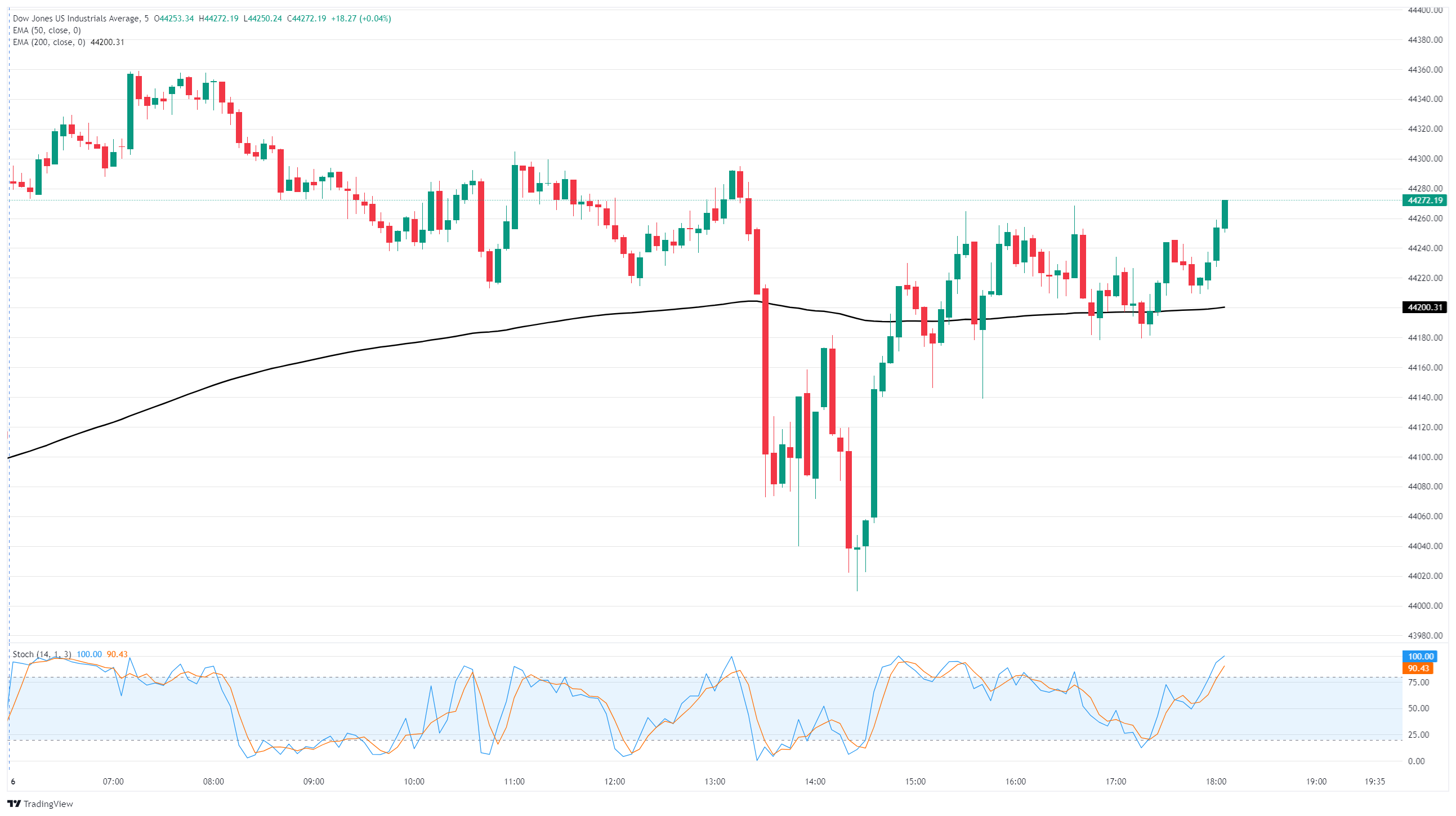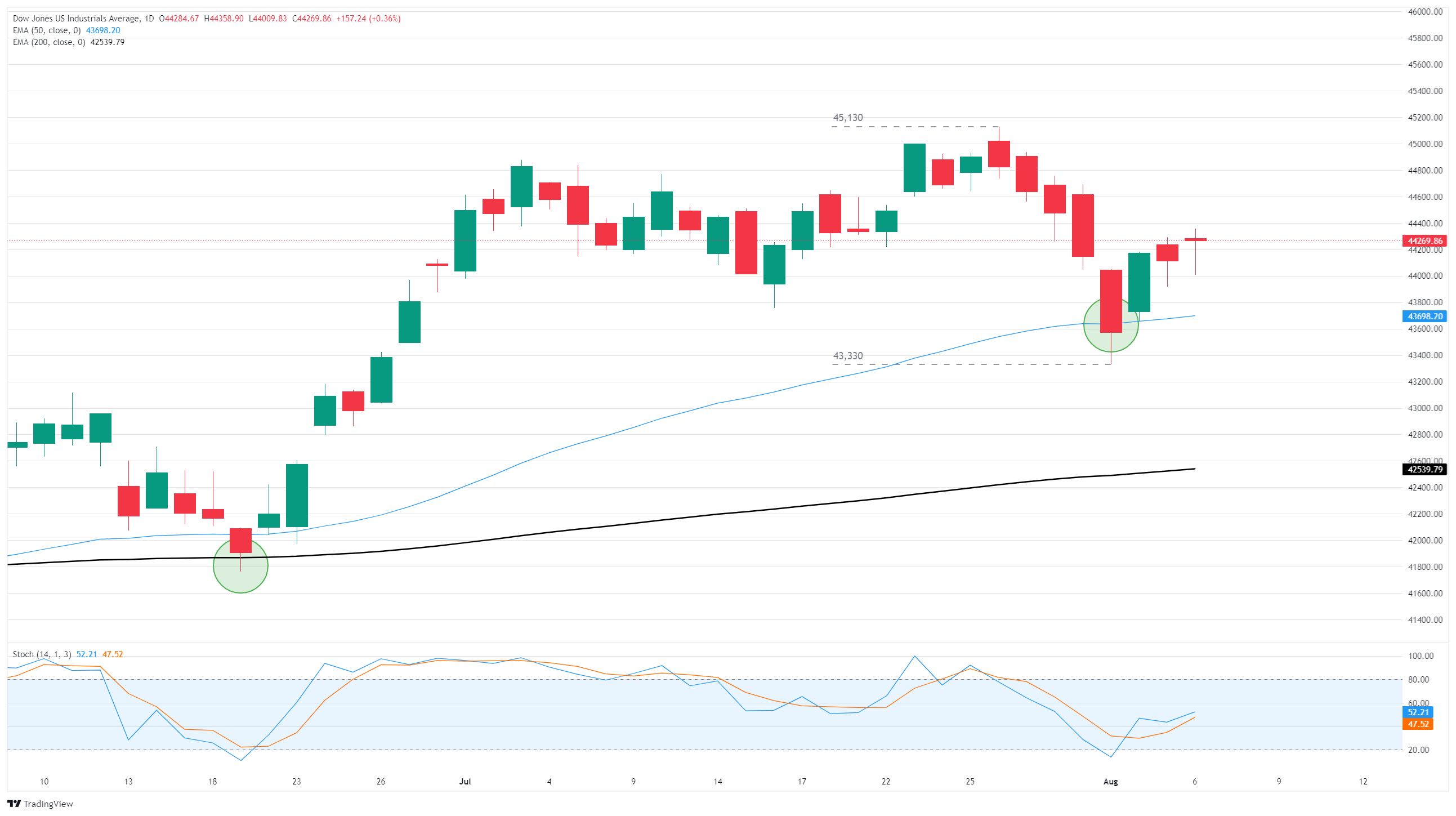Dow Jones Industrial Average jumps on Wednesday, but gains remain limited

- The Dow Jones rose around 100 points from the previous day’s close on Wednesday.
- The Dow is recovering from last week’s one-sided declines.
- A constant cycle of fresh tariff threats continue to weigh on investor sentiment.
The Dow Jones Industrial Average (DJIA) found slim gains on Wednesday, gaining around 100 points from Tuesday’s close. The Dow is testing the 44,250 region as the major equity index rebounds from a near-term low after five straight sessions of declines last week.
The Dow Jones has clawed back nearly half of the declines priced in last week, rebounding around 2% after hitting a near-term low of 43,330. The Dow caught a technical bounce from the 50-day Exponential Moving Average (EMA), now rising into 43,550 as bullish momentum drags price action back into the high end.
Equities claw back losses as rate cut hopes rise
A sharp downgrade to US employment data last week sparked a rebalancing of rate cut expectations from the Federal Reserve (Fed) at its upcoming interest rate decision next month. Markets have piled back into bets that the Fed will deliver at least a quarter-point rate cut on September 17 in an effort to shore up the United States (US) economy, but the potential for a steepening slowdown in job creation, as well as still-stubborn inflation data, is capping continued record-setting index growth.
Earnings season is still in full swing, with over 80% of all reporting companies listed on the Standard & Poor’s 500 (SP500) index posting better-than-expected Q2 results. Mcdonald’s (MCD) rose 2%, climbing into fresh two-month highs above $308.50 per share after beating the street on earnings through the second quarter, while Advanced Micro Devices (AMD) shed over 6% to test below $163.00 per share after flubbing earnings per share forecasts.
Read more stock news: Shopify stock soars 20% as Q2 revenue spikes over 30%
Dow Jones 5-minute chart

Dow Jones daily chart

Dow Jones FAQs
The Dow Jones Industrial Average, one of the oldest stock market indices in the world, is compiled of the 30 most traded stocks in the US. The index is price-weighted rather than weighted by capitalization. It is calculated by summing the prices of the constituent stocks and dividing them by a factor, currently 0.152. The index was founded by Charles Dow, who also founded the Wall Street Journal. In later years it has been criticized for not being broadly representative enough because it only tracks 30 conglomerates, unlike broader indices such as the S&P 500.
Many different factors drive the Dow Jones Industrial Average (DJIA). The aggregate performance of the component companies revealed in quarterly company earnings reports is the main one. US and global macroeconomic data also contributes as it impacts on investor sentiment. The level of interest rates, set by the Federal Reserve (Fed), also influences the DJIA as it affects the cost of credit, on which many corporations are heavily reliant. Therefore, inflation can be a major driver as well as other metrics which impact the Fed decisions.
Dow Theory is a method for identifying the primary trend of the stock market developed by Charles Dow. A key step is to compare the direction of the Dow Jones Industrial Average (DJIA) and the Dow Jones Transportation Average (DJTA) and only follow trends where both are moving in the same direction. Volume is a confirmatory criteria. The theory uses elements of peak and trough analysis. Dow’s theory posits three trend phases: accumulation, when smart money starts buying or selling; public participation, when the wider public joins in; and distribution, when the smart money exits.
There are a number of ways to trade the DJIA. One is to use ETFs which allow investors to trade the DJIA as a single security, rather than having to buy shares in all 30 constituent companies. A leading example is the SPDR Dow Jones Industrial Average ETF (DIA). DJIA futures contracts enable traders to speculate on the future value of the index and Options provide the right, but not the obligation, to buy or sell the index at a predetermined price in the future. Mutual funds enable investors to buy a share of a diversified portfolio of DJIA stocks thus providing exposure to the overall index.







